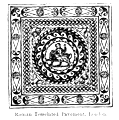Londinium
or
Londīnum. The modern London, the capital of the Cantii in
Britain, originally situated on the southern bank of the Thames in the modern Southwark. It
afterwards spread over the north side of the river, and was hence called a town of the
Trinobantes. It is first mentioned in the reign of Nero as a flourishing and populous town,
much frequented by Roman merchants. It was taken and its inhabitants massacred by the Britons
when they revolted under Boadicea, A.D. 62. The quarter on the north side of the river was
surrounded with a wall and ditch by Constantine the Great or Theodosius, the Roman governor of
Britain. This wall probably commenced at a fort near the present site of the Tower, and
continued along the Minories to Cripplegate, Newgate, and Ludgate. London was the
 |
|
Remains of a Roman Wall, London.
|
central point from which all the Roman roads in Britain diverged. It possessed a
Milliarium Aureum, from which the miles on the roads were numbered; and a
fragment of this Milliarium, the celebrated London Stone, may be seen affixed to the wall of
St. Swithin's Church in Cannon Street. This is almost the only monument of the Roman Londinium
still extant, with the exception of coins, tesselated pavements, and the like, which have been
found buried under the ground.
 |
|
Roman Tesselated Pavement, London.
|
The Roman name Londinium represents the early Keltic
Llyn din,
“fort on the pool,” the pool being a widening of the Thames at this point.
The British London was probably a collection of huts on a dry spot surrounded by a marsh, and
defended by an earthwork and a ditch. London is mentioned by Ptolemy (
Αονδίνιον, ii. 3, 27), Tacitus (
Ann. xiv. 33), Eumenius (
Paneg. Const. 17), and Ammion.
Marc. (xx. 1; xxviii. 3). See
Besant, London (1892).






